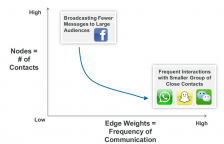Internet trends 2014: 3 highlights for community engagement

Each year, one of the world's most astute tech prophets -- Mary Meeker, partner with the venture capital firm Kleiner Perkins Caufield Byers -- offers observations on current and future internet trends. Her 2014 predictions offer some relevance to digital options for community media -- especially about the fast-ascending dominance of mobile communications and the mobile internet.
While Meeker's insights are geared mainly to a business audience, and most of her statistics are global, the trends she identifies often apply strongly to North America. Here are some highlights this year:
1. Mobile internet use is growing fast, driven by video.In the past year, global mobile internet data traffic grew by a whopping 81%. Video (one of the most data-intensive types of content) is responsible for most of this growth. In North America, mobile internet usage jumped from 11% to 19% of all internet traffic.
Takeaway:Yet another indicator that if your web presence and community outreach efforts aren't as mobile-friendly as possible, you're increasingly missing opportunities to engage your community via the media devices that go everywhere with them (their smartphones).
Also, if you're not already using video (and image sharing services, such as Instagram,) to inform and engage your community, now is the time to start. Meeker's data shows that mobile image sharing is vastly outpacing desktop image sharing.
Mobile advertising: huge engagement opportunity.In Meeker's business jargon, print advertising remains "over indexed" -- which means it continues to command the vastly more advertising revenues than seem warranted given the amount of time most people spend with print media.
Specifically, in the U.S., 19% of all ad dollars currently are spent on print ads, but consumers spend only 5% of their media time with print media. For mobile advertising, this is almost reversed: only 4% of all ad dollars are spend on mobile advertising -- yet consumers spend one fifth of their media time with mobile devices. Meeker starkly notes this as a $30 billion opportunity in the U.S. ad market.
Takeaway:This means that mobile advertising can generally be had pretty cheaply. That's bad news for ad-supported media outlets. But it does mean that mobile advertising might be a very cost effective and highly targetable way to augment your community outreach efforts, to drive local people to your mobile-friendly website and social media.
3. Personal messaging is far more engaging than social media.According to Meeker, while Facebook is a popular and easy way to connect with large groups, people tend to use person-to-person text messaging (and apps that offer similar messaging services, like Apple iMessage) far more frequently in small groups.
Takeaway:While Facebook and other social media are good places to promote your web content, post content directly, and engage with community members and local organizations on a large scale. However, people often use text and similar interpersonal messaging services to share links with their friends -- which carries the substantial weight of both personal recommendations and frequency of contact.
This makes it especially crucial to make your web presence as mobile-friendly as possible, and to link to mobile-friendly content wherever possible (including in your e-mail blasts and newsletters). This leverages the high engagement potential of interpersonal messaging through the entire engagement process.



